“Oh. Great. Cyber-Dogs. This is the worst time for my proton ray run to jam…” – Corporal Raul Lantigua, Advance Team Delta Four, final words
The Premise
Dr. Necreaux has kidnapped the world’s greatest scientists and plans to destroy the planet! An advance strike team has planted a bomb in his lair to prevent that from happening, but failed at escaping with the scientists in tow. It is up to the players to rush in, rescue the scientists, and flee before the bomb goes off. However, Necreaux does not like visitors…
The Rules
The Isle of Doctor Necreaux is a light card-based Co-Op game, setup takes moments. The game comes with two decks: the Character deck, and the Adventure deck. The Character deck represents various traits the player will possess as they race through the depths of the fortress. Most traits are static, but many also contain limited special abilities, called Charges, that can be activated to use. Additionally, most Character cards have subtypes, such as Tech or Heroic, which may help when facing obstacles.
These Character cards make up the player’s avatar in the game. Each player is dealt three Character cards. Players choose one card to keep, passing the others to the next player, and so on until all selections have been made.

This player is a lucky, infiltrator pyrokineticist.
The Adventure deck is comprised of the challenges the players will face, such as Monsters and Traps, as well as various Rooms and Items that may aid the team. The deck is constructed such that The Scientists are somewhere in the middle of the deck, and the Escape Shuttle is in the bottom third.
The Isle of Doctor Necreaux is played between eight and twelve rounds, depending on the number of players. Unlike normal rounds, players take a single turn collectively, similar to Simultaneous Action games. At the beginning of the turn, players resolve any upkeep abilities that require it, then the team chooses to Rest or Move.
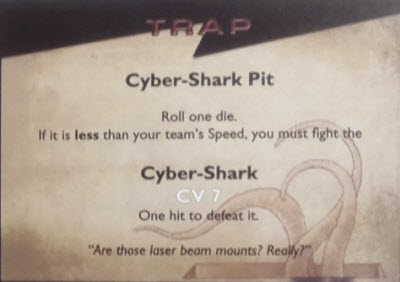
Of course they have laser beams!
When players Move, they select their movement Speed for the turn, dictating the number of Adventure cards they will attempt to encounter. One at a time, Adventure cards are revealed and resolved. With the exception of Items (which are set aside until a Monster is defeated), most cards require the team to pass simple success/fail checks using six-sided dice.
The most dangerous of these are Monster cards, where combat ensues. Here, players must defeat them or else retreat and end the turn. To defeat a Monster, players must collectively roll higher than the Monster’s difficulty (called a CV) a number of times equal to the number of players. (For example, a Monster with a CV 4 facing three players requires three rolls of 5 or higher.)
Any dice roll lower than the CV amount results in the team taking damage. For each damage taken, the players must decide which Character card receives it. A point of damage to a face-up card causes that card to flip over, rendering its powers inert. A point of damage to a face-down card removes the card from the game. Should a player lose all of their Character cards, they die.
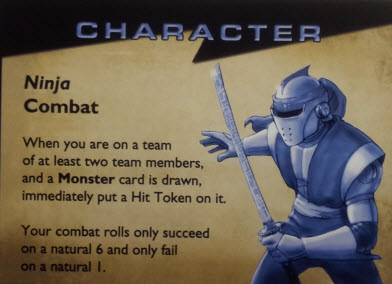
This ninja is again ready to fight.
If players choose the Rest option, instead of moving, each player is allowed to heal one of their Character cards by flipping it face up and/or placing a Charge counter on a card. The team then looks at the top Adventure card and decides whether they wish to keep it there or not.
After either the Rest or Move action is resolved, any end of turn effects happen, and the Countdown Clock ticks down one round. If the Clock ever reaches zero, the players lose, having failed in their mission of recovering the scientists and saving their own skin. Alternatively, if the players have the Escape Shuttle but not the scientists, they may opt to escape the island but leave the scientists to their possible demise. Their status as heroes is forever revoked.
However, if the player’s quarry is located and escape secured, then the players win – probably in some kind of dashing style.
Logical Inconsistencies
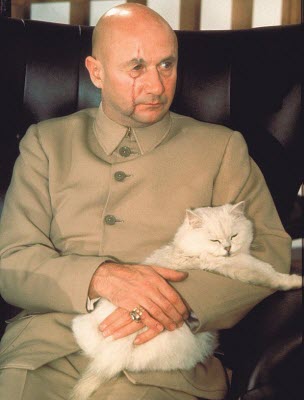
“Twelve seconds. One of these days we must invent a faster-working venom.”
If you’ve ever seen a classic spy serial like early James Bond or The Man From U.N.C.L.E., you’ve heard this story before. There’s an evil genius on the loose, and he’s trying to take over the world. In The Isle of Doctor Necreaux, it would appear that the evil genius gene hasn’t died out completely. The game takes place at an undisclosed future point in time, but the flavor is very retro futuristic, akin to something out of a Ray Bradbury novel. Part homage and part parody, this game takes you on a campy but entertaining jaunt through a volcanic lair (clearly the best kind of lair) to stop the bad guy.
Indeed, the touchstone to this game is not its mechanics, but the story-driven narrative it offers. Since so much of the game is random – the Character traits available, the perils you face, etc. – the game never unfolds in quite the same way. Rather than mitigate that fact, though, it embraces it. Necreaux is played out as if it were a Choose Your Own Adventure story: there’s certainly a way to win, but poor decision-making or bad luck can ensure you won’t get there. In fact, there are some scenarios where players may have to choose whether only part of the team escapes alive in order to succeed.
Since the game doesn’t have any roleplaying or world-building motifs directly though, expect your Immersionists to focus (or fixate) on this storytelling aspect. However, chances are they are going to find occasional gaps in the stories that don’t always make sense, like:
-Why does a Monster suddenly become less difficult if a player drops dead?
-If a bomb has already been planted to stop Dr. Necreaux, haven’t the players sort of won already since the doomsday machine will never go off?
-Even as the B-team, wouldn’t a bunch of secret agents have brought some kind of gear to start with?
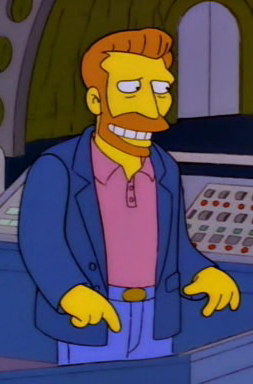
Hank Scorpio – he loves German beer!
Still, these disparities don’t affect the functional side of the game. If players can accept some suspension of disbelief in those circumstances, it makes for a fun experience. Players can take the game at their own pace and make it as serious or as campy as the group desires.
This is certainly appealing for Socializers. The Isle of Doctor Necreaux is a fairly short game and can be taught rather quickly. Players work cooperatively, make team-based decisions, and even take their turn together. This alleviates the need to be well versed in rules to be engaged. When you add in the storytelling flavor and that much of the game comes down to mere luck, Necreaux is a surprisingly good fit for this group.
Using Your Instincts
The area where the game stumbles slightly is in the rules themselves. The Isle of Doctor Necreaux was not designed to be complicated by any stretch, and for the most part, it isn’t. The rulebook is concise and straightforward enough (one major typo aside) to play the game most of the time without issue. It can occasionally run into cases, however, where certain card interactions are unclear on how to resolve and players must decide on interpretation. Because almost every Adventure card and Character card is unique, it’s tough to catch every interaction. So, the odds of such an event are higher than your normal light game. It adds a fantastic level of variety, but the tradeoff is occasional judgement calls.
That said, an area it could simply be cleaner is in the player terminology. Just remember this: The Team is all players, The Character is you, and Character cards make up your Character. Various cards care about each of those differently.
Trained To Be Unpredictable
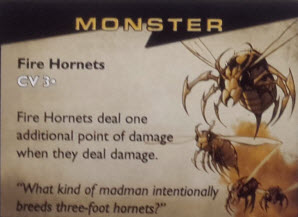
The answer is obviously one who couldn’t breed four-foot hornets.
In The Isle of Doctor Necreaux, being successful requires a decent amount of luck. Avoiding traps, dodging patrols, having the right gadget at the right time? Pretty chancy.
Even still, because so much of the randomness here is the result of game mechanics rather than player decisions, don’t expect Daredevils to jump at this one. There needs to be player cohesion overcome this gauntlet, and there’s little room for risky ventures beyond deciding how many Adventure cards are attempted each round.
Since you never know what the next turn brings, it’s practically impossible to develop a long term strategy. Most decision-making is made on the fly, and it’s made in a group consensus. As a result, it’s unlikely to excite Tacticians either. They may enjoy some of the minor nuances, such as when you use certain Charge abilities or gauging the aforementioned Speed for the turn, but it’s unlikely to hold their interest beyond a playthrough or two.
On the other hand, Strikers should find the game appealing. Necreaux has a very direct and linear path to victory: get the scientists and get out. This sets a clear goal to attain, and they’ll appreciate that aspect. The game is not about being overly clever or acquiring a personal arsenal of trinkets. Rather, it’s simply to win or die trying. While this fact will deter Architects too from liking it, Strikers will enjoy the Us vs. The Game co-op experience this game offers.

Time’s almost up.
The Takeaway
The Isle of Doctor Necreaux is a light, luck-centric co-op game. It distills the stories of the meglomaniachal madman down into a portable and flavorful game that can be played in under an hour and with a variety of audiences. Its hallmark attribute is its cheeky narrative structure that has players running down hallways and fending off danger at every step. The game does have a certain amount of clunkiness to it at times around certain card interaction rules, but that doesn’t prevent it from being enjoyable in general. Indeed, the game has enough ludicrous situations that a bit of incongruity is forgivable – and even cherished in some respects. Necreaux isn’t flashy, but it offers up a small, team-oriented game with a simple premise. If you’re after something that’s easy to learn and whose charm is felt through the experience of seeing what’s around the next corridor, you don’t need an evil genius to tell you that The Isle of Doctor Necreaux could be one to check out.
The Isle of Doctor Necreaux is a product of AEG.
Cardboard Republic Snapshot Scoring (Based on scale of 5):
Artwork: 3
Rules Clarity: 3.5
Replay Value: 3.5
Physical Quality: 3.5
Overall Score: 3.5
Photo Credits: Blofeld by United Artists; Hank Scorpio by Fox Studios.
